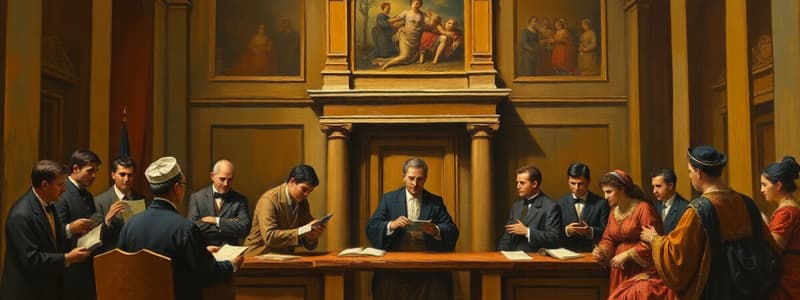Podcast
Questions and Answers
What is the primary function of the Judicial Branch?
What is the primary function of the Judicial Branch?
- To enforce laws through law enforcement agencies
- To create laws for the government
- To interpret laws and ensure their alignment with the Constitution (correct)
- To provide legal representation to individuals
Which of the following courts is considered the highest authority in the Philippine judiciary?
Which of the following courts is considered the highest authority in the Philippine judiciary?
- Shari’a Court
- Supreme Court (correct)
- Regional Trial Court
- Court of Appeals
What jurisdiction do Shari’a Courts specifically handle?
What jurisdiction do Shari’a Courts specifically handle?
- Civil cases involving large sums of money
- Criminal cases of public officials
- Disputes related to personal Muslim law such as marriage and inheritance (correct)
- All cases of criminal nature in the regional area
What is the maximum age limit for serving as a Supreme Court Justice?
What is the maximum age limit for serving as a Supreme Court Justice?
Which court has the authority to review appeals from lower courts?
Which court has the authority to review appeals from lower courts?
Which of the following is NOT a qualification for becoming a Supreme Court Justice?
Which of the following is NOT a qualification for becoming a Supreme Court Justice?
What is the primary purpose of the Katarungang Pambarangay?
What is the primary purpose of the Katarungang Pambarangay?
What types of cases do Regional Trial Courts (RTCs) primarily handle?
What types of cases do Regional Trial Courts (RTCs) primarily handle?
Flashcards
Judicial Branch Role
Judicial Branch Role
Interprets laws, settles disputes, and ensures laws match the Constitution.
Supreme Court Role
Supreme Court Role
Highest court, reviews laws for constitutionality and settles final appeals.
Supreme Court Justices
Supreme Court Justices
1 Chief Justice and 14 Associate Justices make up the high court.
Judicial Review
Judicial Review
Signup and view all the flashcards
Regional Trial Courts (RTCs)
Regional Trial Courts (RTCs)
Signup and view all the flashcards
Sandiganbayan
Sandiganbayan
Signup and view all the flashcards
Shari'a Courts Jurisdiction
Shari'a Courts Jurisdiction
Signup and view all the flashcards
Court of Appeals
Court of Appeals
Signup and view all the flashcards
Which court handles disputes between two municipalities?
Which court handles disputes between two municipalities?
Signup and view all the flashcards
How long do Supreme Court Justices serve?
How long do Supreme Court Justices serve?
Signup and view all the flashcards
What are the qualifications to be a Supreme Court Justice?
What are the qualifications to be a Supreme Court Justice?
Signup and view all the flashcards
What is the role of the Court of Appeals?
What is the role of the Court of Appeals?
Signup and view all the flashcards
What is the purpose of Katarungang Pambarangay?
What is the purpose of Katarungang Pambarangay?
Signup and view all the flashcards
How is the Philippine judiciary structured?
How is the Philippine judiciary structured?
Signup and view all the flashcards
Study Notes
Overview of the Judicial Branch
- The Judicial Branch interprets laws, settles disputes and ensures laws adhere to the Constitution.
Structure of the Judiciary
- The Philippine judiciary is comprised of the Supreme Court and lower courts including RTCs, Municipal Trial Courts, Court of Appeals, Sandiganbayan, and Shari'a Courts.
The Supreme Court
- The Supreme Court acts as the highest court.
- It resolves final appeals and examines the constitutionality of laws.
Composition of the Supreme Court
- The Supreme Court has 1 Chief Justice and 14 Associate Justices.
Judicial Review
- Judicial Review allows the Supreme Court to evaluate the constitutionality of laws and actions.
Functions of the Supreme Court
- Administrative: Oversees the entire judicial system.
- Judicial: Resolves disputes and reviews laws.
Regional Trial Courts (RTCs)
- RTCs handle significant criminal and civil cases exceeding ₱300,000.
Sandiganbayan
- The Sandiganbayan hears cases of corruption and malfeasance involving public officials.
Shari'a Courts
- Shari'a Courts deal with Muslim personal laws like marriage and inheritance.
Katarungang Pambarangay
- Katarungang Pambarangay facilitates dispute resolution at the barangay level to reduce court congestion.
Court of Appeals
- The Court of Appeals reviews appeals from RTCs and other lower courts.
Qualifications of Supreme Court Justices
- To be a Supreme Court Justice, one must be a natural-born Filipino, at least 50 years old, have 15 years of legal experience (as a lawyer or judge), and demonstrate integrity and impartiality.
Tenure of Supreme Court Justices
- Supreme Court Justices serve until they reach age 70, are incapacitated, or removed by impeachment.
Court Jurisdictions
- Municipal Circuit Courts oversee disputes between municipalities.
Studying That Suits You
Use AI to generate personalized quizzes and flashcards to suit your learning preferences.
Description
This quiz explores the structure, functions, and key components of the Judicial Branch in the Philippines. Topics include the Supreme Court, lower courts, and the concept of judicial review. Test your knowledge about how the judiciary interprets laws and ensures constitutional adherence.




